Blazing a trail forward: Torey Crosby shares his experiences navigating campus with disabilities
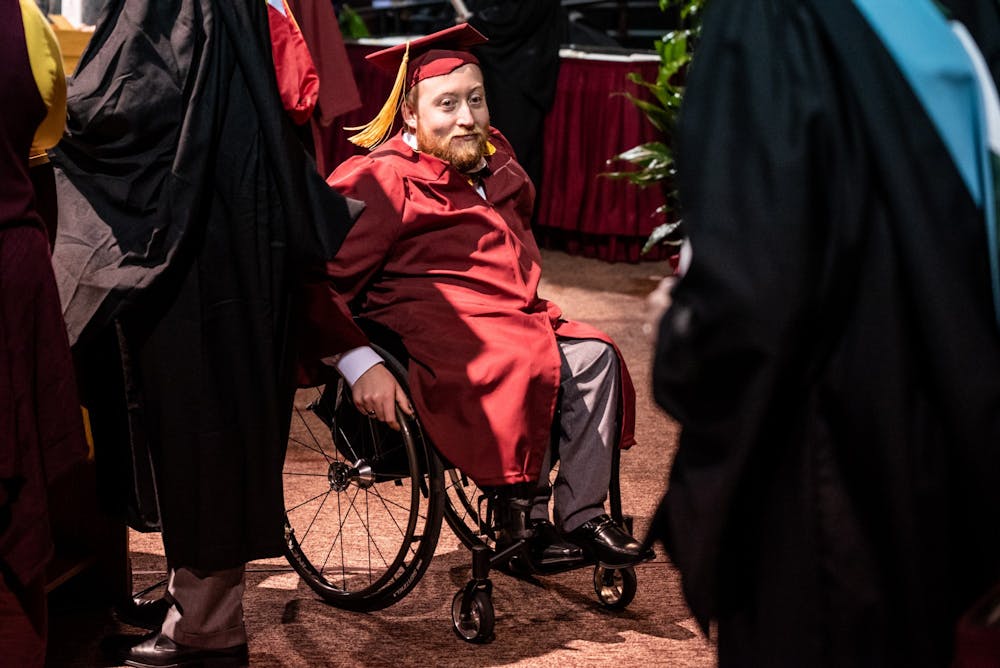
Torey Crosby receives a diploma during the Central Michigan University Fall Commencement Ceremony Dec. 14 at McGuirk Arena.
An escort waited for Torey Crosby at the John G. Kulhavi Events Center. Donning his cap and gown, the Vestaburg, Michigan senior was shown to the elevator and entered McGuirk Arena from a special access door, where he joined more than 1,300 other students waiting for their names to be called during the December 2019 commencement ceremony.
Navigating roadblocks while traveling from point A to point B on Central Michigan University's campus is a challenge that Crosby knows all too well. He was born with spina bifida: a condition that created a hole in his vertebrae that exposed the spinal cord and required surgery. The operation resulted in him losing the ability to use his legs. He’s been in a wheelchair ever since.
In the early hours of Dec. 14, Crosby posted a message on Facebook to ease his restlessness before the commencement ceremony.
Crosby's words were echoed by President Bob Davies during his address to graduates.
"I'm not here to follow the footsteps laid before me," President Bob Davies said. "I'm here to blaze new trails, so that when I blaze those new trails others can blaze their own trails. Tor Crosby, you are an inspiration to many, for what you do, and for the way you act."
President Bob Davies thanked Crosby, and asked him to go to his parents sitting in the front row and thank them for raising him. Crosby wheeled up the aisle to the music of applause.
From his unique perspective, Crosby identifies problems others don't seem to see. Prior to commencement, Crosby contacted his colleagues to point out that the university's commencement application didn't give him an opportunity to arrange his wheelchair accommodations. He emailed the director of commencement ceremonies, and his message was passed on to a team that worked with him so that he could participate in commencement.
“I find different ways to do the things I want to do,” Crosby said.
He credits his parents for instilling the mindset in him that he can do anything that other people can do. It’s one of the reasons why he doesn’t refer to himself as disabled, but differently-abled.

Torey Crosby travels down a ramp Nov. 26 in the University Center. Crosby said the ramp is too steep to climb back up.
His challenges navigating CMU’s campus in a wheelchair began in middle school, when Crosby was on a field-trip with his Spanish Club. Several different schools attended an event at the Bovee University Center. Crosby remembers students being led to the building’s main entrance where they climbed the steps to get to the building's second floor. Though there was an elevator nearby, no one in the group was able to locate it.
“Luckily the group I was in had some football players who hauled me up the steps,” Crosby said.
The classmates who carried him had played it off like it wasn’t a big deal, but it was a very big deal to Crosby, who’d thought for a moment that he wouldn’t be able to participate in the field-trip that he’d been looking forward to.
Confronted by his disability, this was the wake-up call that started him on the trail he's still blazing today.
Crosby’s story highlights the issue that elevators can be “out of sight, out of mind”. Putting up more signs, including ones that hang from the ceiling so that they’re more visible, could be a part of the solution. He believes more can be done than just having a single sign on the wall next to the elevator.
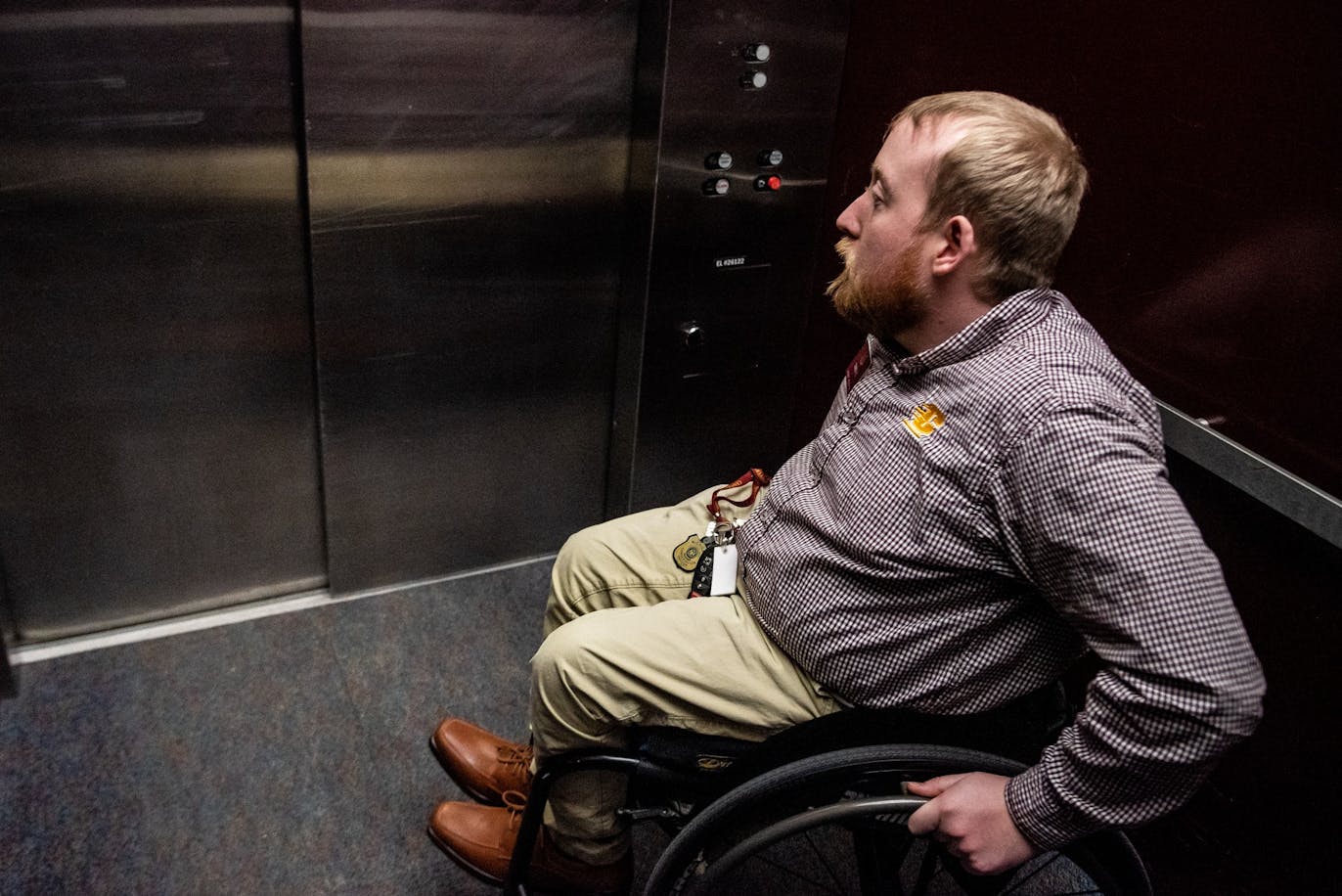
Torey Crosby waits to exit an elevator traveling between the first and second floor Dec. 13 in the Student Activity Center. Crosby said elevators on campus lack proper signage and are difficult to find.
An example of better signage is the office for Student Disability Services, located inside the Charles V. Park Library. It is past a couple automatic glass-doors, through a maze of aisles lined by desks and moving bookshelves, with many signs to guide the way. Some signs hang from the ceiling with large lettering, like you might typically find in a hospital or airport. Others are on the walls with directions in braille, although one of them can’t be read because there is a glass-door that slides in front of it when you get close.
People on campus are listening to what he has to say.
Student Disability Services Office Director Michelle Veith said she hadn't heard about elevators being difficult to find, but said she would be happy to pass along the information as well as the signage suggestions to Facilities Management. She also encouraged students who have concerns that relate to disability to reach out to the Student Disability Services. If it’s not within the purview of the SDS, they will work to connect the student to the right people so that their needs can be properly addressed.
“The Student Disability Services Office can be tricky to find at first,” Michelle Veith, director of the SDS, said. “However, it is my understanding that it was intentionally placed in the current location to give students more privacy.”
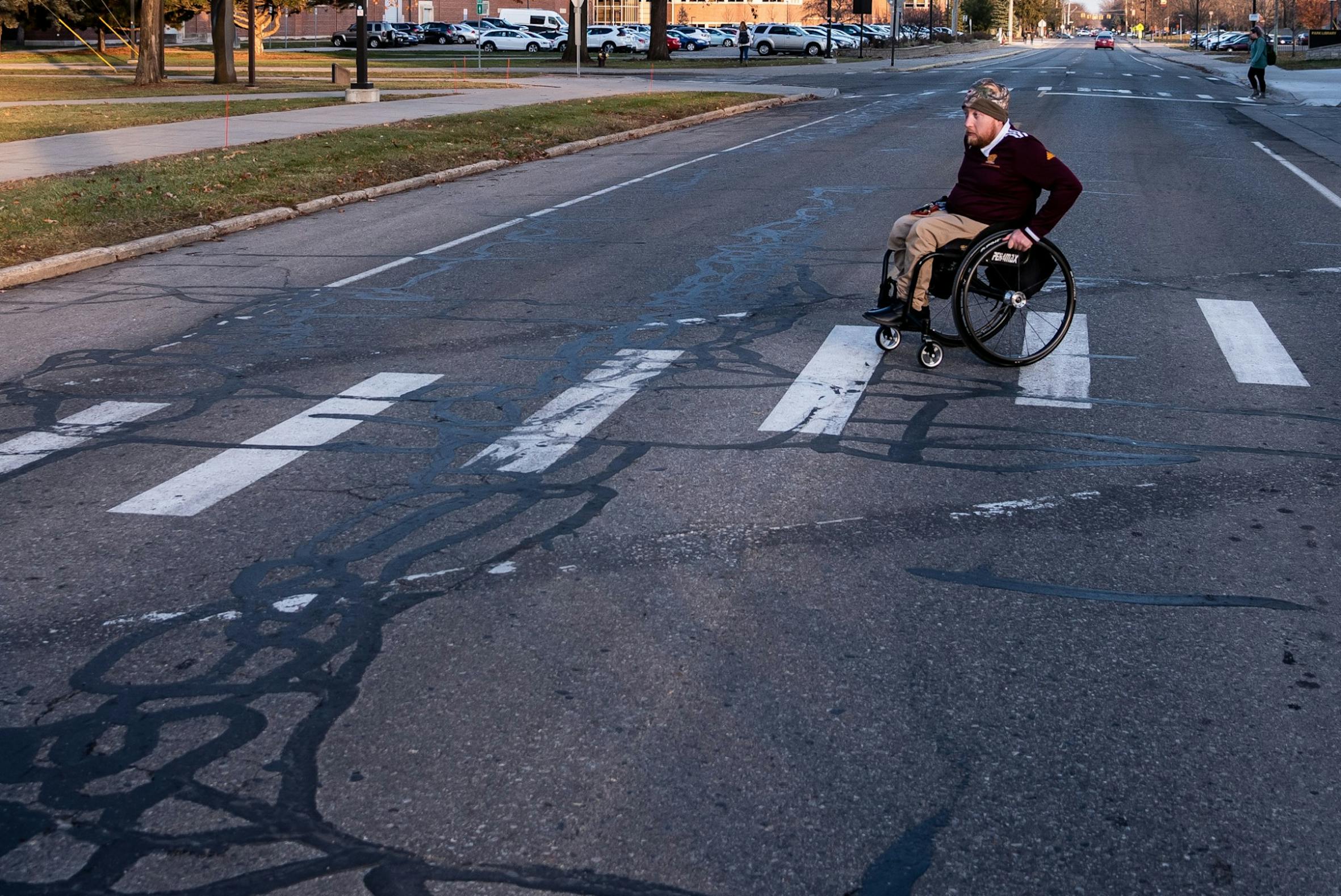
Torey Crosby crosses East Preston Nov. 26 outside Charles V. Park Library. Crosby said he rarely attempts to cross at intersections to avoid blaring horns and staring drivers.
Crosswalks are another obstacle that a person with Crosby’s needs must think about every day. In his wheelchair, Crosby is harder for drivers to see because he sits low to the ground. Some drivers he encounters are impatient at the fact that it takes him more time to cross.
Some drivers seem hostile to him because he's in a wheelchair. He describes the looks drivers give him – as if he’d wronged them. Sometimes they make gestures telling Crosby to “hurry up.” Some even start inching forward while he’s still in the middle of crossing, the same thing that would happen if the driver didn’t see Crosby, making it all the more nerve wracking for him. He goes out of his way to look for crosswalks that are less busy, or avoids them altogether.
It gets worse in the winter.
Not just the conditions of the crosswalks, but the parking lot and sidewalk system in general. After a storm, Facilities Management focus on maintaining the “critical path”. These are among the first walkways to be cleared when it comes to snow and ice removal. Inclement weather is an inconvenience to all of us, but to somebody like Crosby it can quickly become more than that.
The critical path is necessary because it ensures that people in wheelchairs can move around the campus, as well as see other potential hazards. A busted section of concrete or a drain in the ground becomes like a pothole, damaging the wheelchair or getting it stuck. These could get hidden by snow, so keeping the walkways clear is a safety measure that assists people like Crosby in more ways than one.
The critical path graphic is a good resource that shows the location of elevators and automatic doors all across campus. It can be found online.
“I’ve had friends and acquaintances of mine who use wheelchairs come to me and ask for a tour because I would be thinking of their needs,” Crosby said. “I remember one of them saying they don’t know how I’ve dealt with this on a daily basis. But that’s where I go back to my philosophy. I don’t let things get in my way.”
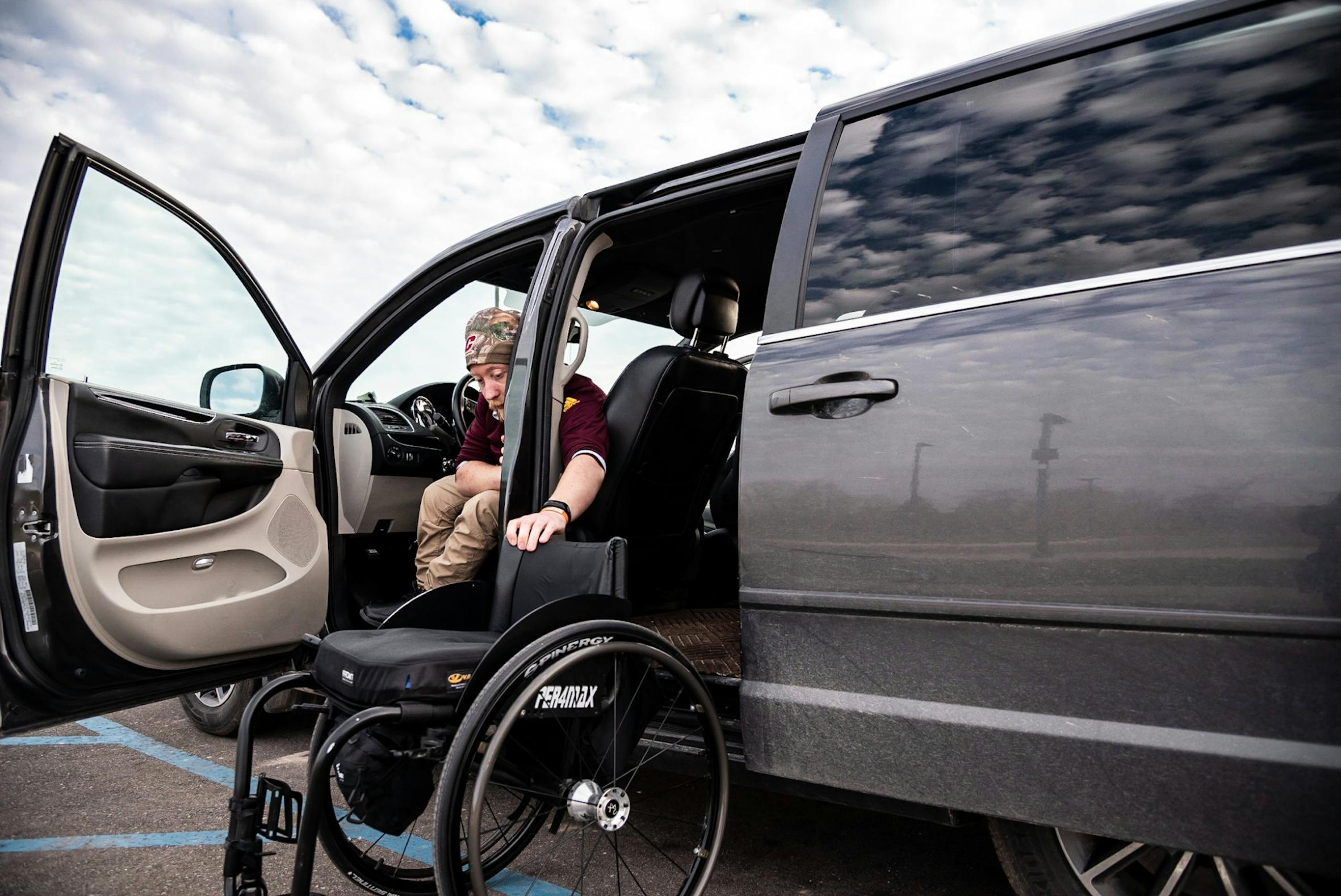
Torey Crosby pulls his wheelchair into his van Nov. 26 in the parking lot outside the Student Activity Center. Crosby's van has been modified allowing him to drive.
Crosby’s track-record speaks for itself. Besides wheelchair tennis outside of school, at Southwest Minnesota State University he played wheelchair basketball. He’s had his Dodge Caravan professionally modified with hand-controls that are connected to the foot-pedals, allowing him to drive. He had the same thing done to his vehicle that he uses for hunting.
As an intern for University Recreation, Crosby wants to spread this “go get it” philosophy through the work he’s doing with Assistant Vice President Stan Shingles. He wants to bring attention to challenges faced by individuals who have unmet needs, and create new opportunities by advocating for an adaptive recreation program at Central Michigan University.
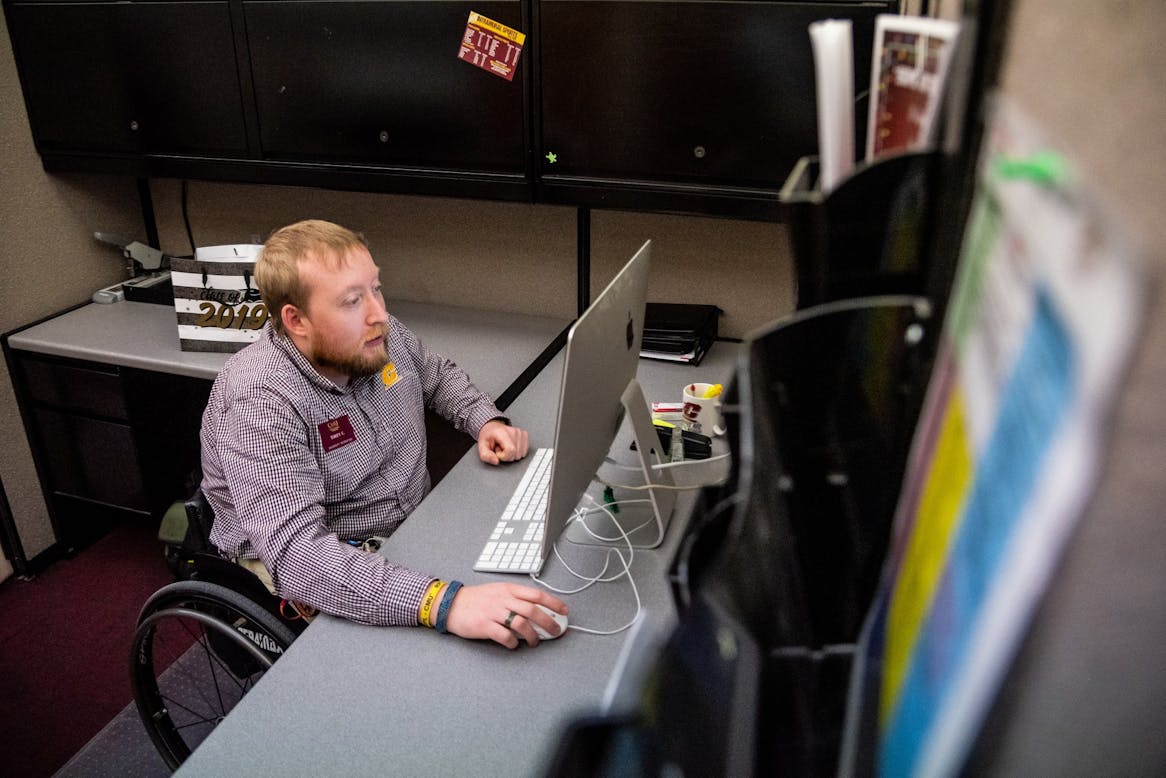
Torey Crosby checks his schedule from his desk Dec. 13 in the University Recreation office in the Student Activity Center. Crosby's last day working in the SAC was spent setting up for graduation.
“Torey’s an exceptional young man,” Shingles said. “He’s very dedicated, extremely passionate, and he wants to do well. I knew him just a little bit because he’s a [Recreation, Parks and Leisure] major. One day he said, ‘I’m looking for an internship,’ so I put him in contact with our staff who screen for that process and hired him at the end of the spring semester.”
Since he started, Crosby has worked with University Recreation full-time, participating in staff meetings and getting involved with training and development. He’s working on a proposal for an adaptive recreation program, partly informed by his personal experience with wheelchair sports and the outdoors. It would be geared toward differently-abled individuals, as well as those who may have cognitive differences such as post-traumatic stress.
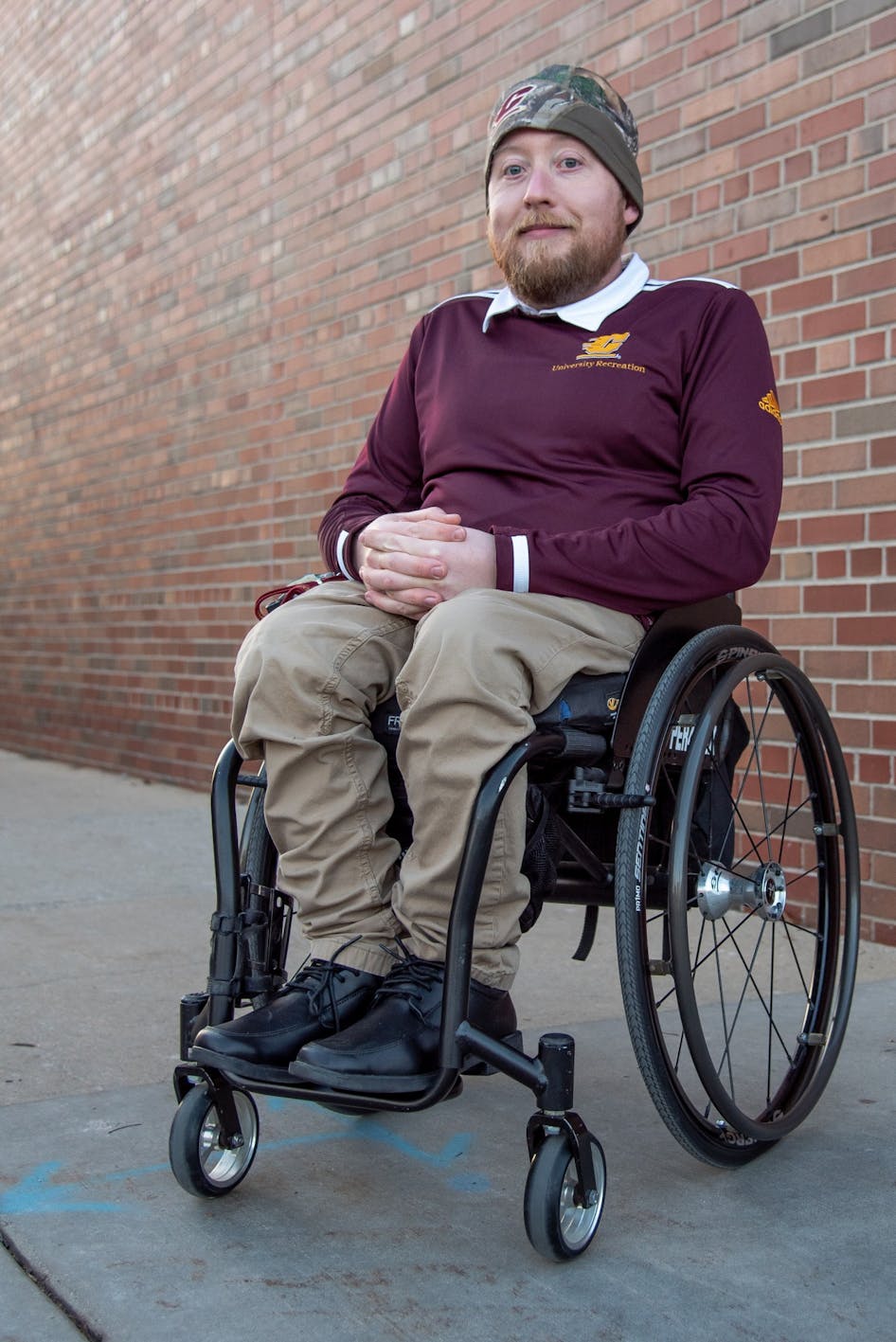
Torey Crosby poses for a photo Nov. 26 outside the University Center.
“Torey’s made our staff more purposeful in understanding our students who have disabilities,” Shingles said. “One of the things we haven’t gotten our arms around is what type of adaptive recreation we should be offering. What’s the demand? What’s the need? That’s the work he’s been doing for us.”
Make no mistake. Crosby enjoyed his time at Central Michigan University. He sees the people he’s come to know through the years as family. His critique of the campus does not come from a place of malice, but from his recognition that there are areas in which the school is capable of improving.
Many situations will have roadblocks for him, Crosby understands that. He wants to make the most of the chance he’s been afforded – to identify these challenges and bring them to the attention of the people who can address them – by creating a positive, lasting dialogue about how to make the campus more accessible to all of its students.
As he said in his own words, he’s here to blaze a trail not just for himself, but also for others.






